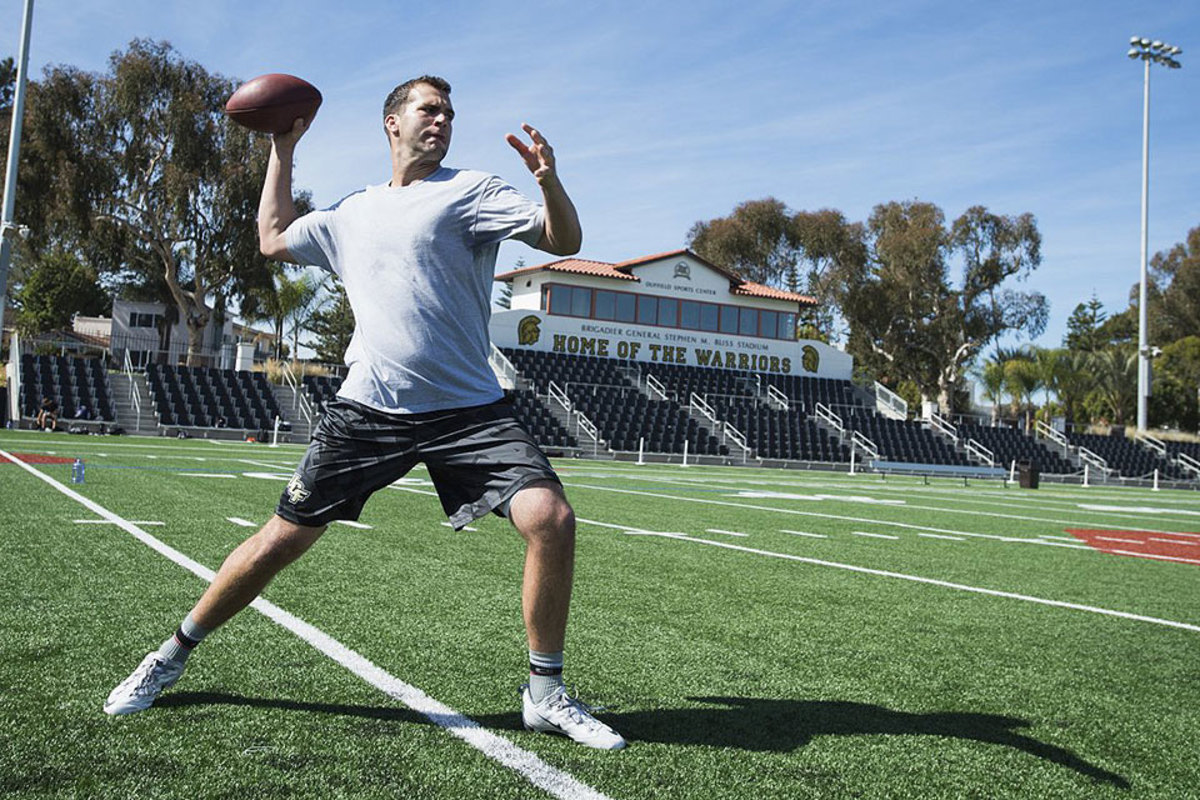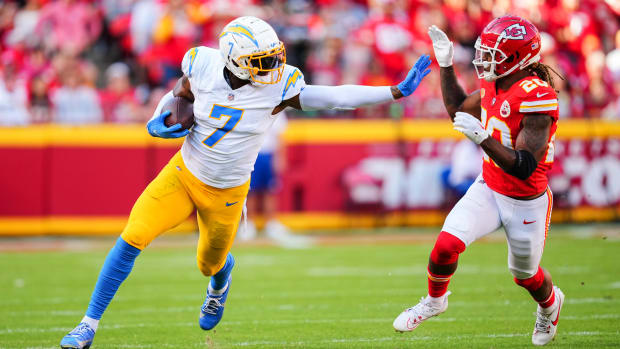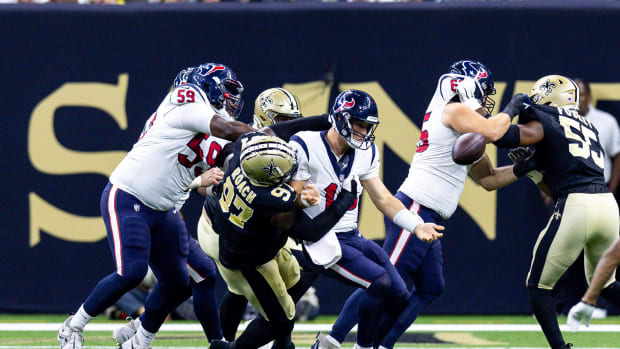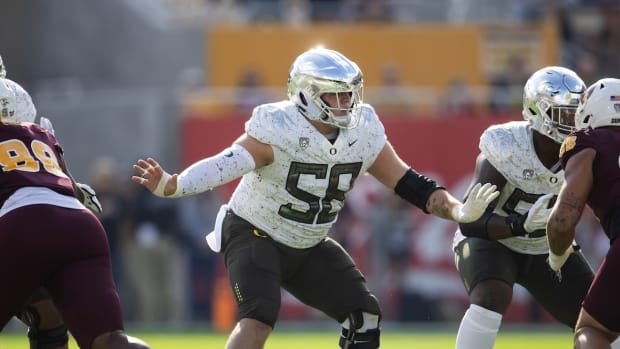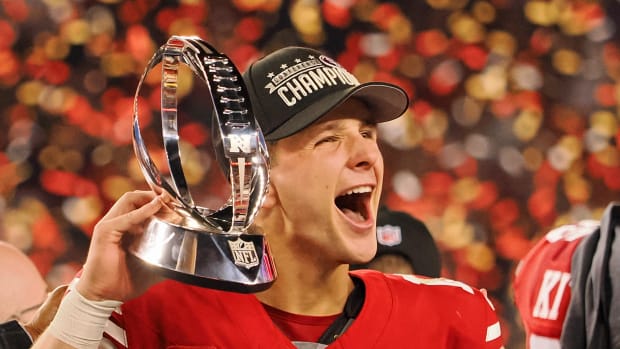The Bortles Conundrum
If you could take the best quarterback in the 2015 draft this May, knowing that you probably wouldn’t get much from him in ’14—and even then he’s still not a sure thing—where would you draft him?
Would you still take him first overall in this talent-laden draft? How about the middle of the first round? Or would you not consider him until the second round?
That, essentially, is the conundrum with Central Florida quarterback Blake Bortles.
After watching six of his games on coaches film (against Penn State, South Carolina, Memphis, Louisville, Houston and Baylor), two things seem fairly certain about Bortles: 1) He possesses all of the traits teams look for in a franchise quarterback, and 2) he has the highest ceiling of any QB in this draft.
But he’s just not ready yet.
In a perfect world, Bortles would have stayed in school one more season, fixed the potentially ruinous weaknesses in his game, been the top pick in the 2015 draft and immediately started on the first day for his new franchise.
But Bortles declared for the draft and is available now. That means teams will have a harder time trying to project his future than they would a year from now. That brings more questions into the process: where should we take him, and how long will it take him to fully develop?
The positives
Despite the rise in smaller and more mobile quarterbacks, the NFL is still ruled by quarterbacks who execute from the pocket. And if you were to create a quarterback from scratch, Bortles would check every box. It’s why he’s near the top of this year’s draft class.
[si_video id="video_BCB68056-988E-F4E4-E318-D56F2E9FEF80" height="470"]
Bortles, 22, is 6-foot-5 and a very solid 232 pounds, with long arms and decent hand size (11th among quarterbacks at the combine). He is built to withstand the beating that a quarterback can take in the pocket. And despite his 4.93 seconds in the 40-yard dash, Bortles is a good athlete at the position and will be productive with his legs, just as he was in college. While the Knights run a multiple offense, they were primarily a read-option team and Bortles was very much a part of that structure. He made plays with his feet and wasn’t afraid to take a hit. He was also asked to make many throws on the move.
On film, he looks to have above average arm strength and can make all the throws required by an NFL offense. Bortles possessed a good grasp of his offense and his opponents’ defensive schemes, and he had the ability to make checks and some audibles at the line of scrimmage.
He also does a great job of keeping his eyes downfield while bodies are flying around him, and he’s not afraid to step up in the pocket and make throws into tight windows.
- This outstanding throw against Penn State shows the promise of Bortles (even his ability to have great touch on deep passes), and it looked even better on the coaches’ film from the end-zone angle.
- This throw, on the game-winning drive against Louisville, shows Bortles’ ability to stand strong in the pocket, anticipate and load up on a throw when needed.
(Both linked videos come from DraftBreakdown.com, which does great work on NFL prospects.)
Blake Bortles has the prototypical size—6-5, 232—of an NFL quarterback. (Erik Isakson for Sports Illustrated/The MMQB)
When it comes to projecting great quarterbacks, what you can’t see is often more important than physical skills. Bortles also measures up in this regard. According to a source on the Knights’ coaching staff, Bortles has “off the charts” intangibles. He’s a great leader, extremely bright and a tireless worker who lives and breathes football. Bortles also seems to have a short memory, meaning mistakes don’t linger. Those are all must-haves when considering a quarterback prospect.
The negatives
If Bortles played in the NFL right now, he would be a turnover machine and would probably flame out because his mechanics, mostly in the lower body, are extremely flawed.
While Bortles has problems with an inconsistent delivery—it can range from short and compact to long and wild—the biggest problem is his feet. Bortles is constantly stepping into a bucket, or stepping away from the throw instead of toward the receiver. Not only does that lead to accuracy issues, the ball also loses energy very quickly and underthrows are common on deep passes.
Bortles has sloppy footwork even in a clean pocket. More troublesome is that when he feels pressure, Bortles will stare down receivers, his footwork breaks down even more and the likelihood of a turnover increases greatly. In this way, he is similar to another unfinished NFL pocket passer: the 49ers’ Colin Kaepernick. But Bortles doesn’t have Kaepernick’s wheels to help in the playmaking department.
Here are two examples of Bortles’ subpar mechanics against Penn State.
- With this throw, Bortles had a mostly clean pocket in the red zone and a window to fit the touchdown in. But instead of stepping into the throw and snapping it to the receiver, he opened his feet and was nearly intercepted.
- Bortles was not as lucky on this throw to the sideline, which was intercepted.
These are just a few examples, but you can find dozens in each of Bortles’ games. If you really want a horror show, watch the game against Memphis (17 of 36 for 160 yards). You’d think Bortles was undraftable. (The South Florida game, I've been told, is similar.)
Bortles could get away with these fundamental and troubling breakdowns most of the time in college because of the level of competition. The NFL isn’t nearly as forgiving. In two games against the best athletes he faced in college (Ohio State in ’12 and South Carolina ’13), Bortles completed just 63.6% of his passes and threw five of the 16 interceptions (31%) he had over those two seasons. If Bortles doesn’t clean up his footwork before hitting an NFL field, he will be in trouble.
Bortles’ mechanical problems are correctable and could be managed if given time and reps with coaches known for developing quarterbacks.
Another factor that gets lost when discussing Bortles is that, contrary to popular belief, he did not put the UCF program on his back and lift it up to national prominence all by himself. He is not Jay Cutler at Vanderbilt nor is he Brett Favre at Southern Mississippi. UCF won football games on the back of a stingy defense that ranked 17th nationally, allowing 21.3 points per game, and a running game that was powered by Storm Johnson (1,139 yards and 14 touchdowns), who could make an immediate impact as a three-down back in the NFL this fall depending on where he lands.
Bortles was not the featured player in the Knights’ offense. The scheme ran first through Johnson and fellow running back William Stanback, and then a quartet of talented playmaking receivers: Rannell Hall, Breshad Perriman, J.J. Worton and Jeff Godfrey. The Knights’ offense was built around the running game, and getting the ball into the hands of the playmakers in a dink-and-dunk passing game featuring plenty of screens. Bortles did a very good job managing all the weapons and making clutch plays when needed, but UCF was far from the “Blake Bortles Show” that most franchise quarterbacks headline in college.
The bottom line
Bortles’ mechanical problems, both with his delivery and footwork, are alarming because they seem to consistently break down when he’s under the most pressure. And most quarterbacks, no matter how well they are taught, revert back to their worst habits in the most stressful times.
However, they are correctable and could be managed if given time and reps with coaches known for developing quarterbacks. Bortles just needs to be drilled to square his shoulders, stride toward the target and drive the ball. If you want to watch the best, pop in a tape of Tom Brady, who is one of the most fundamentally sound passers in NFL history. One of Brady’s former coaches, new Texans coach Bill O’Brien, has a reputation for developing passers who have terrific mechanics. Houston, by the way, happens to be in need a franchise quarterback. Bortles possesses everything O’Brien looks for at the position; Bortles just needs some work.
With the new collective bargaining agreement locking first-round picks into four-year contracts, with a fifth year at the club’s option, Bortles undoubtedly will go in the first round because a team will want that type of control, especially over a player who probably needs a season on the sideline.
So if you’re O’Brien and the Texans, would you take a talent like Bortles first overall and bet on yourself that you can unlock greatness? If you wanted to trade down and take Bortles later on, how long do you wait?
Welcome to the Bortles conundrum.
































